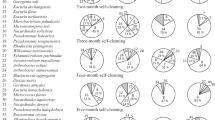Abstract
Microbial decontamination of hydrocarbon-polluted soil was paralleled with soil respiration measurements. About 1,500 tons of a loamy top soil were found to be contaminated with approximately 2000 mg/kg of aliphatic hydrocarbons, mainly oleic (C18:1) and linoleic acid (C18:2) found in the vicinity of a linoleum manufacturing and then a car dewaxing plant. The contaminated soil was analysed for dry matter, pH, dehydrogenase activity, electrical conductivity and nutrient content viz. nitrate, phosphorus and potassium, as well as a number of indigenous microbes. The soil was low in salt and nutrients. This paper describes the procedure and measures to decontaminate this bulk soil on site from approx. 2,000 to 500 mg of aliphatic hydrocarbons/kg dry matter by use of a nutrient emulsion, indigenous micro-organisms and aeration over 13 months. This 75% reduction in aliphatic hydrocarbons resulted in a concomitant carbon efflux, measured as soil respiration, and was used to calculate carbon fluxes.
Similar content being viewed by others
References
Akhlaq, M.S. (1997): Polycyclic aromatic hydrocarbons in crude oil-contaminated soil: A two-step method for the isolation and characterisation of PAHs. ESPR — Environ. Sci. & Pollut. Res.4, 217–222
Alef, K.;Nannipieri, P. (1996): Methods in Applied Soil Microbiology and Biochemistry. Academic Press London
Blanke, M.M. (1996): Soil respiration in an apple orchard. Environmental and Experimental Botany36, 339–342
Ellis, B. (1992): On site and in situ treatment of contaminated sites. In:Rees, J.E (Ed.) Contaminated land treatment technologies. Elsevier Applied Science, London, pp. 30–46
Lotter, S.; Heerenklage, J.; Stegmann, R. (1993): Carbon balance and modelling of the oil degradation in soil bioreactors. In: Soil decontamination using biological processes (proceedings), International Symposium Dechema 6.–9.12.1992
Parkinson, K.J. (1981): An improved method for measuring soil respiration in the field. Journal of Applied Ecology18, 221–228
VDLUFA (1991): Methodenbuch Bd. I. Die Untersuchung von Böden. Darmstadt, 1991
Verhagen, C.;Smit, E.;Janssen, D.B.;van Elsas, J.D. (1995): Bacterial dichloropropene degradation in soil; screening of soils and involvement of plasmids carry the dhlA gene. Soil Biology and Biochemistry 27, 1547–1557
Author information
Authors and Affiliations
Rights and permissions
About this article
Cite this article
Wibbe, M.L., Blanke, M.M. Aliphatic hydrocarbons in an oil-contaminated soil. Environ. Sci. & Pollut. Res 6, 2–6 (1999). https://doi.org/10.1007/BF02987112
Received:
Accepted:
Issue Date:
DOI: https://doi.org/10.1007/BF02987112



